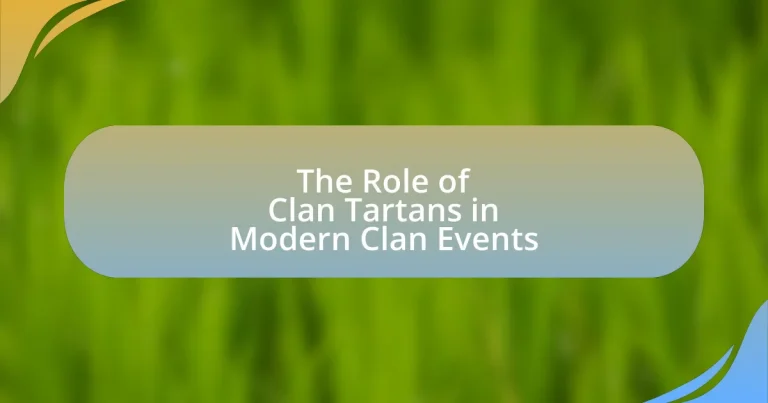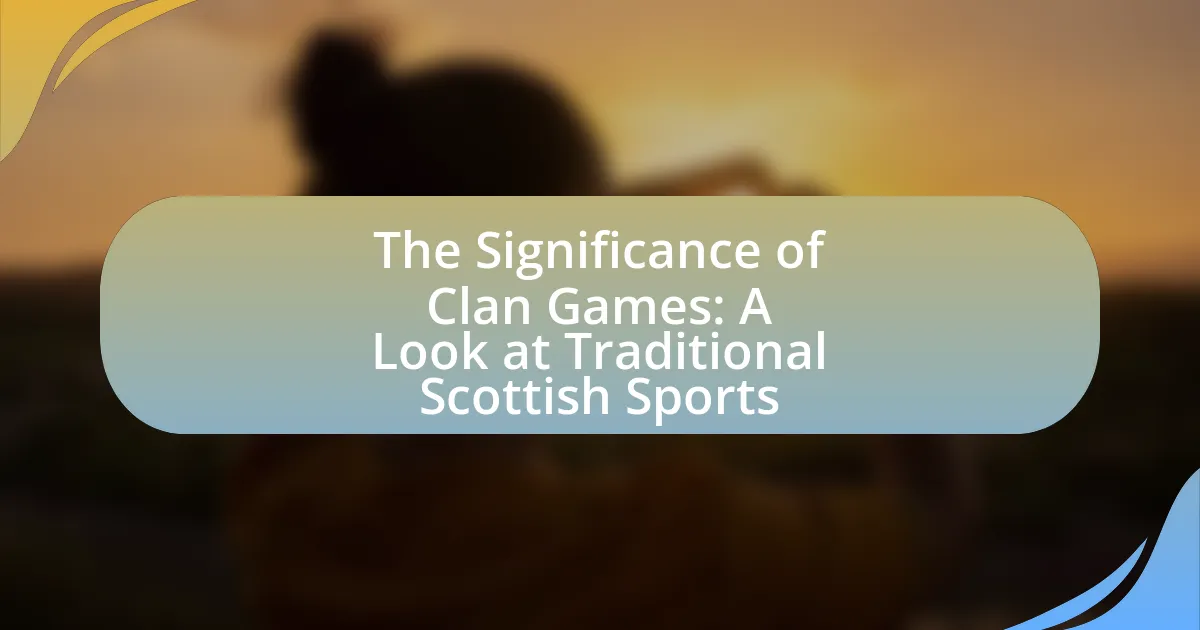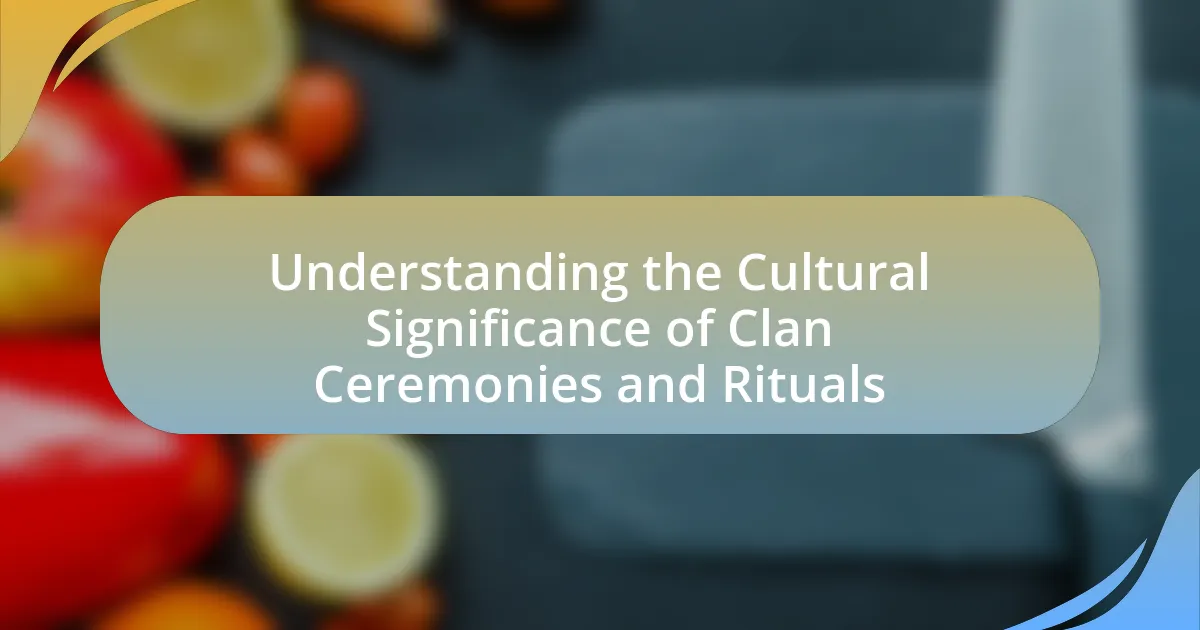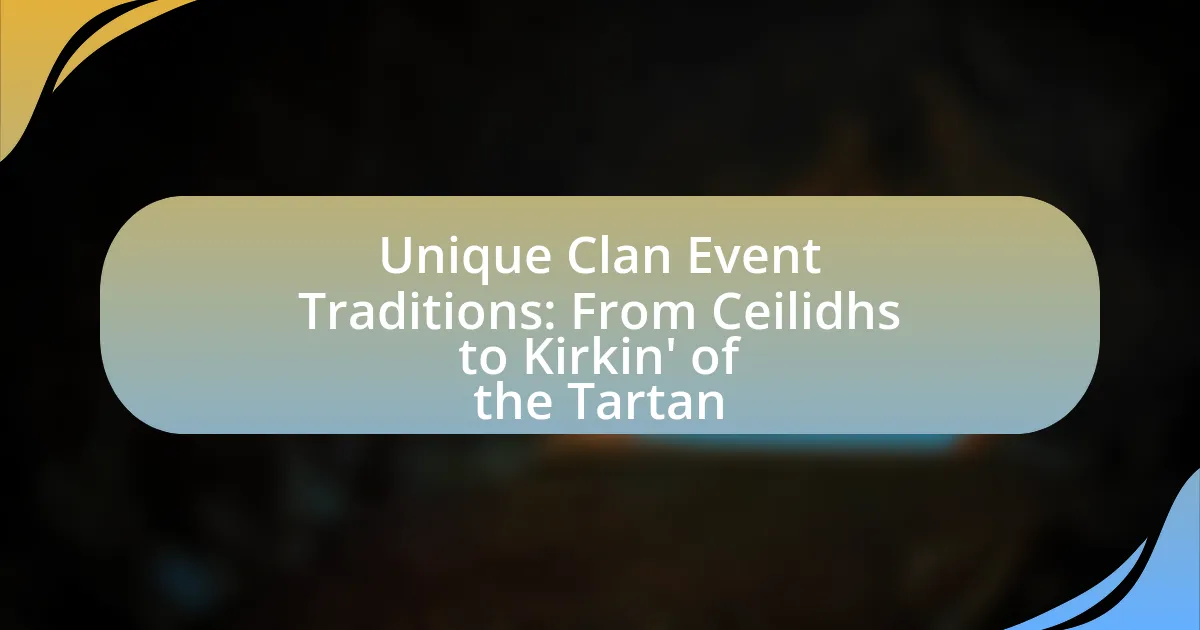Clan tartans are significant symbols of heritage and identity in modern clan events, representing specific Scottish clans and fostering a sense of belonging among members. Historically rooted in the 16th century, these distinctive patterns have evolved to reinforce communal bonds during gatherings, such as Highland games and family reunions. The article explores the cultural importance of clan tartans, their role in preserving traditions, and their impact on modern Scottish identity, while also addressing practical considerations for their use in contemporary events. Key aspects include the visual appeal of tartans, their historical context, and best practices for showcasing clan identity effectively.
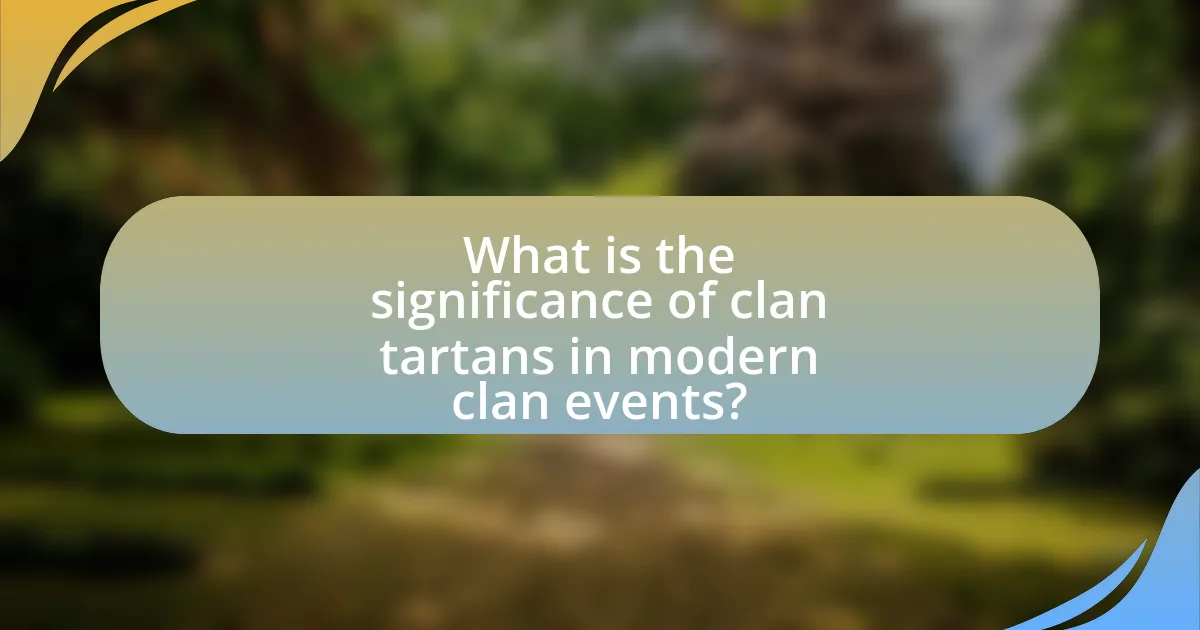
What is the significance of clan tartans in modern clan events?
Clan tartans hold significant cultural and identity value in modern clan events, serving as symbols of heritage and unity among clan members. These distinctive patterns represent specific clans, allowing individuals to express their lineage and connection to their ancestry during gatherings. Historically, tartans have been used to signify clan affiliation since the 18th century, and their presence at events reinforces communal bonds and shared traditions. The wearing of clan tartans fosters a sense of belonging and pride, as members come together to celebrate their shared history and identity.
How do clan tartans represent clan identity?
Clan tartans represent clan identity by serving as unique patterns that symbolize the heritage and lineage of specific Scottish clans. Each tartan design is associated with a particular clan, reflecting its history, values, and traditions. For example, the MacLeod tartan features distinctive colors and patterns that are recognized as emblematic of the MacLeod clan, fostering a sense of belonging among its members. Historically, tartans were used to identify individuals on the battlefield and have evolved into a symbol of pride and unity during clan gatherings and events, reinforcing the collective identity of clan members.
What historical context surrounds the use of clan tartans?
Clan tartans originated in Scotland during the 16th century, serving as a symbol of identity for various Scottish clans. The use of distinct patterns allowed clans to differentiate themselves, especially during conflicts and gatherings. Historical records indicate that tartans were often associated with specific regions and clans, with the earliest documented use appearing in the 1530s. The 19th century saw a revival of interest in tartans, particularly after the publication of “The Scottish Gael” by John Sobieski Stuart, which helped standardize clan patterns. This historical context underscores the tartan’s role as a marker of heritage and unity among clans, influencing their continued significance in modern clan events.
How do clan tartans foster a sense of belonging among members?
Clan tartans foster a sense of belonging among members by serving as a visual symbol of shared heritage and identity. The distinct patterns and colors of each clan’s tartan connect individuals to their ancestral roots, reinforcing a collective identity that transcends geographical boundaries. Historical evidence shows that tartans were originally associated with specific Scottish clans, creating a strong bond among members who wore them during gatherings and events. This practice not only promotes unity but also instills pride in one’s lineage, as clan members recognize their connection to a larger community with shared traditions and values.
Why are clan tartans important for cultural heritage?
Clan tartans are important for cultural heritage because they serve as symbols of identity and belonging for Scottish clans. Each tartan pattern is unique to a specific clan, representing its history, values, and traditions. The use of tartans in modern clan events reinforces communal ties and fosters a sense of pride among members. Historically, tartans were used to distinguish clans during conflicts and celebrations, making them integral to Scottish culture. The continued practice of wearing clan tartans at gatherings, such as Highland games and family reunions, highlights their role in preserving and promoting cultural heritage.
How do clan tartans contribute to the preservation of traditions?
Clan tartans contribute to the preservation of traditions by serving as visual symbols of heritage and identity for specific clans. Each tartan pattern is uniquely associated with a clan, reflecting its history, values, and lineage, which fosters a sense of belonging among members. The use of tartans in modern clan events, such as gatherings and festivals, reinforces these connections by encouraging participants to wear their clan’s colors, thereby promoting cultural continuity. Historical records indicate that tartans have been used since the 16th century, and their revival in the 19th century during the Scottish Romantic movement further solidified their role in celebrating and maintaining Scottish traditions.
What role do clan tartans play in modern Scottish identity?
Clan tartans serve as a significant symbol of modern Scottish identity by representing heritage, unity, and cultural pride. Each tartan is associated with a specific clan, allowing individuals to express their lineage and connection to Scottish history. The resurgence of interest in clan tartans, particularly during events like Highland Games and clan gatherings, reinforces communal bonds and fosters a sense of belonging among Scots and those of Scottish descent. This cultural revival is evidenced by the increasing popularity of tartan in fashion and home decor, highlighting its role as a contemporary emblem of Scottish identity.

How are clan tartans utilized in contemporary clan events?
Clan tartans are prominently utilized in contemporary clan events as symbols of heritage and identity. Participants often wear tartan clothing, such as kilts and sashes, to represent their specific clan, fostering a sense of belonging and unity among members. Additionally, clan gatherings frequently feature tartan displays, including banners and flags, which visually reinforce clan affiliation and pride. The use of tartans in these events is rooted in Scottish tradition, where each pattern is unique to a clan, thus serving as a historical link to ancestry and cultural legacy.
What types of events commonly feature clan tartans?
Clan tartans commonly feature at events such as Highland games, clan gatherings, weddings, and cultural festivals. These events celebrate Scottish heritage and often encourage participants to wear their respective clan tartans to signify identity and pride. For instance, Highland games, which include athletic competitions and traditional music, prominently display clan tartans as a way to honor Scottish traditions. Similarly, clan gatherings and reunions serve as occasions for members to connect and showcase their tartans, reinforcing familial bonds and cultural identity.
How do clan gatherings incorporate tartans into their ceremonies?
Clan gatherings incorporate tartans into their ceremonies by prominently displaying these patterned fabrics as symbols of heritage and identity. During events, participants often wear kilts, sashes, or other garments made from clan-specific tartans, which visually represent their lineage and connection to their clan. Additionally, tartans are used in ceremonial banners and flags, enhancing the atmosphere of unity and tradition. The significance of tartans is rooted in Scottish history, where each pattern is associated with a specific clan, reinforcing the cultural importance of these gatherings.
What role do tartans play in competitions and games?
Tartans serve as a symbol of identity and heritage in competitions and games, particularly in Scottish events such as Highland Games. They represent specific clans or families, fostering a sense of community and pride among participants. For instance, during competitions, athletes often wear their clan tartan to signify allegiance and honor their lineage, which enhances the cultural experience of the event. The use of tartans in these contexts not only promotes tradition but also encourages camaraderie among competitors, as they share a common cultural background.
How do clan tartans enhance the visual appeal of events?
Clan tartans enhance the visual appeal of events by providing a vibrant and distinctive aesthetic that represents cultural heritage. The unique patterns and colors of each tartan create a striking visual identity, making participants easily identifiable and fostering a sense of unity among clan members. Historical significance also plays a role; tartans often symbolize lineage and tradition, which adds depth to the visual experience. For instance, during Scottish festivals, the display of various clan tartans not only beautifies the event but also educates attendees about the rich history and diversity of Scottish clans, reinforcing cultural pride and connection.
What are the aesthetic elements of clan tartans in event settings?
Clan tartans in event settings are characterized by their distinctive patterns, colors, and cultural significance. The aesthetic elements include the specific color combinations that represent different clans, the intricate designs that often feature stripes and checks, and the overall visual impact that these patterns create when worn collectively by clan members. For instance, the use of bold colors can evoke a sense of pride and unity among participants, while the historical context of each tartan adds depth to its aesthetic appeal. The visual harmony achieved when clan members wear matching tartans enhances the atmosphere of events, reinforcing cultural identity and tradition.
How do colors and patterns influence the atmosphere of clan events?
Colors and patterns significantly influence the atmosphere of clan events by evoking emotions and fostering a sense of identity among participants. The use of specific colors in clan tartans, such as blue for loyalty or green for nature, creates a visual representation of the clan’s values and heritage, enhancing the emotional connection to the event. Patterns, particularly those unique to each clan, serve as a symbol of unity and pride, reinforcing group cohesion and belonging. Historical evidence shows that clans have used distinct tartans for centuries to signify their identity, which contributes to a shared atmosphere of camaraderie and celebration during events.

What are the practical considerations for using clan tartans in events?
Practical considerations for using clan tartans in events include ensuring accurate representation of the clan’s heritage, selecting appropriate fabric and design for the occasion, and adhering to cultural protocols. Accurate representation is crucial as clan tartans symbolize identity and lineage; using the correct tartan fosters a sense of belonging and respect among clan members. The choice of fabric and design should reflect the event’s formality; for instance, heavier wool may be suitable for outdoor events, while lighter materials could be preferred for indoor gatherings. Additionally, understanding and following cultural protocols, such as the proper way to wear tartans and the significance of specific patterns, enhances the authenticity of the event and honors clan traditions.
How can clans choose the right tartan for their events?
Clans can choose the right tartan for their events by considering their specific heritage, the occasion’s significance, and the traditional patterns associated with their clan. Each tartan is linked to a particular clan or family, often reflecting historical ties and regional origins. For example, the Scottish Tartans Authority provides a comprehensive database of tartans, allowing clans to identify their official patterns. Additionally, clans should consider the event’s formality; for instance, formal gatherings may call for more traditional or ceremonial tartans, while casual events might allow for more contemporary designs. This approach ensures that the chosen tartan not only represents the clan’s identity but also aligns with the event’s atmosphere and purpose.
What factors should be considered when selecting a tartan?
When selecting a tartan, factors to consider include the clan affiliation, the occasion for which the tartan will be worn, and the color scheme that aligns with personal preferences or cultural significance. Clan affiliation is crucial as it connects individuals to their heritage; for example, specific patterns are traditionally associated with particular clans, such as the MacLeod or Campbell tartans. The occasion influences the choice, as formal events may require specific dress codes that dictate the tartan style, such as a kilt for weddings or formal gatherings. Additionally, the color scheme should resonate with the wearer’s aesthetic or the event’s theme, as tartans can vary widely in color combinations, each carrying its own historical context and meaning.
How do clan members ensure authenticity in their tartan choices?
Clan members ensure authenticity in their tartan choices by consulting official clan registries and adhering to established patterns recognized by the Scottish Tartans Authority. These registries provide verified designs that represent specific clans, ensuring that members select tartans that accurately reflect their heritage. Additionally, clan societies often provide guidelines and resources to educate members about the historical significance and proper usage of their clan’s tartan, reinforcing the importance of authenticity in their choices.
What tips can enhance the use of clan tartans in modern events?
To enhance the use of clan tartans in modern events, individuals should incorporate them into various aspects of the event, such as attire, decorations, and promotional materials. Utilizing clan tartans in clothing, like kilts or scarves, allows participants to display their heritage visibly, fostering a sense of unity and pride. Additionally, incorporating tartan patterns in event decorations, such as tablecloths or banners, creates a cohesive theme that celebrates clan identity. Furthermore, using clan tartans in promotional materials, including invitations and programs, reinforces the cultural significance of the event. These practices not only honor tradition but also engage attendees, making the event more memorable and meaningful.
How can clans effectively showcase their tartans during events?
Clans can effectively showcase their tartans during events by prominently displaying them through various means such as banners, clothing, and accessories. Utilizing large banners featuring the tartan pattern at event entrances or booths captures attention and reinforces clan identity. Additionally, clan members wearing traditional attire made from their tartan, including kilts and sashes, creates a visual representation of heritage and unity. Accessories like ties, scarves, and hats can further enhance visibility. Historical evidence shows that clans have used tartans as symbols of identity since the 18th century, making their display at events a continuation of this tradition.
What best practices exist for incorporating tartans into event planning?
Incorporating tartans into event planning involves selecting appropriate tartan patterns that reflect the heritage and identity of the clan. Event planners should research the specific tartans associated with the clan, ensuring that they are historically accurate and meaningful. For instance, using the clan’s official tartan for decorations, attire, and promotional materials reinforces cultural significance and fosters a sense of unity among attendees. Additionally, integrating tartan elements into the event’s theme, such as table settings or banners, enhances the visual appeal and authenticity of the event. This practice is supported by the historical importance of tartans in Scottish culture, where they symbolize clan identity and pride.
